Rostock is one of the northern German cities, which grew with the Hanseatic League’s trade and financial success, and its historical wealth has been the source to a lot of constructions, that can be seen today as well. Large churches, the region’s oldest university and a lot of culture are some of the things you can look forward to in Rostock, which has also benefited from the investments of both former dukes and the GDR.
Rostock is a small metropolis with all that it entails. Business districts and shopping malls, good restaurants and a varied cityscape provide many choices of activities during a visit. A walk in the city center is the best way to explore the city where it is never far between sights.
Rostock’s churches and gates stand as some of the city’s highlights from the booming era of rich trade around the Baltic Sea, including the time of the Hanseatic League. Marienkirche and Sankt Petri Kirche are the two best known churches, while Nikolaikirche’s new apartments in part of the building are quite special. In addition, several preserved city gates and parts of the wall from Rostock’s defense are still to see.
Architecturally, Rostock also offers interesting examples from the GDR era, where elementary construction was part of many buildings. In Rostock, the buldings were inspired by the Hanseatic era. The maritime element is clear since it is not far to the Baltic Sea, where the seaside resort of Warnemünde at the mouth of the Warnow River is a natural destination for an excursion out of town.
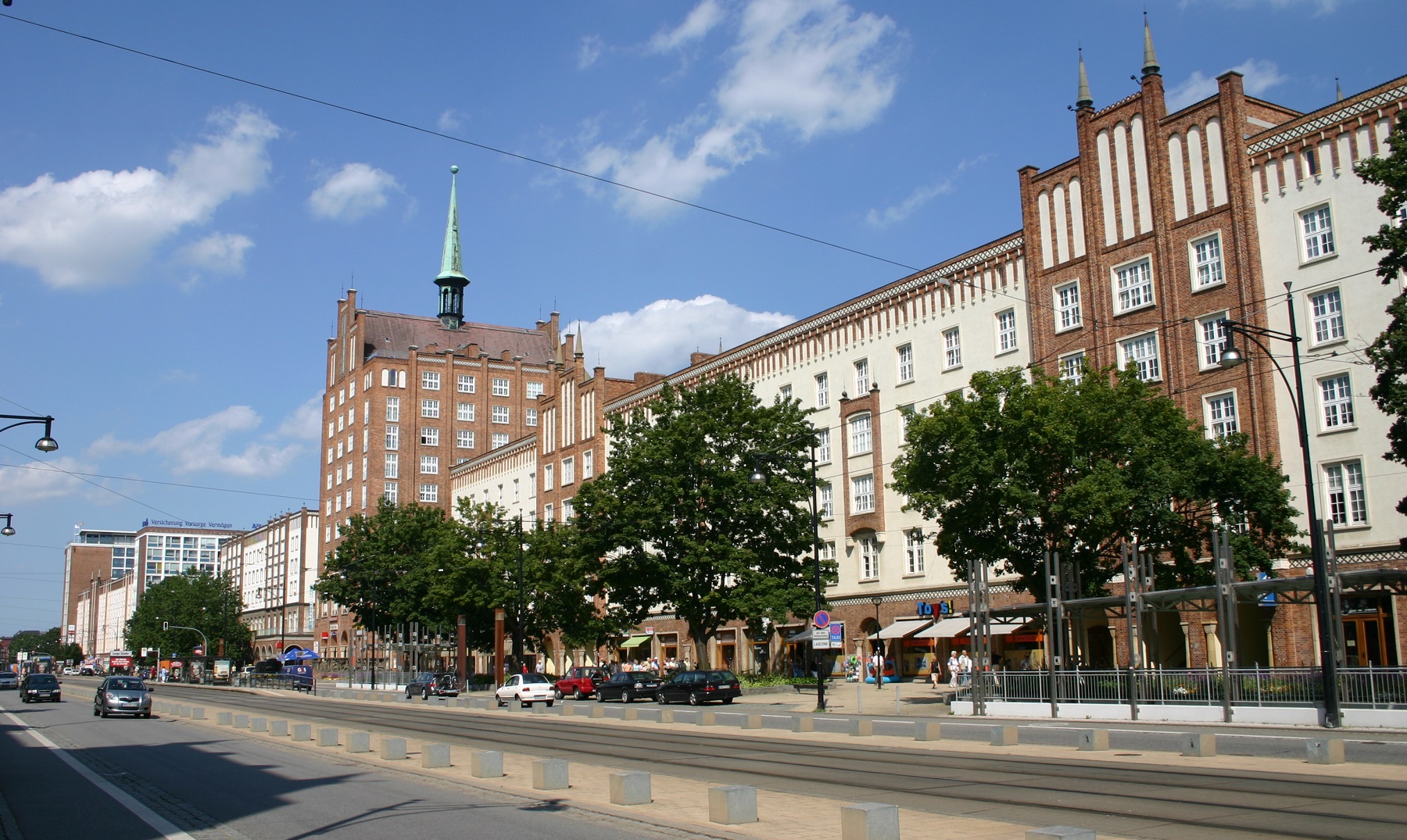
The street Lange Straße is a wide street with a series of imposing 20th-century buildings on each side. The former buildings in the street were almost destroyed during British bombardments 23-27. April 1942, and this enabled a total renovation, which made room for the new buildings.
The current buildings were built in the early reconstruction phase of the GDR era, when the buildings were much cherished. They were to stand as a symbol of the skills of socialism and as a confident landmark for the most important port city in the GDR.
On January 30, 1953, the General Secretary of the GDR Central Committee, Walter Ulbricht, laid the foundation stone for the new street, which was originally planned in the style of Stalinist Classicism, but with Rostock’s history in mind, one vessel after another was instead built in a kind of modern Hanseatic architecture in very grand style.
As a symbol of the state’s ability, in the years 1953-1957 Lange Straße was called the Street for National Genrejsning/Straße des Nationalen Aufbauwerks.
Kröpeliner Straße is Rostock’s leading shopping street, and in addition to the many good shops, you can admire several old houses with high gables, beautiful squares and generally a nice atmosphere here in the middle of the city center.
At the western end of the street stands the city gate Kröpeliner Tor, which was the historical entrance to the city from, among other places, Lübeck and Wismar. Along the street you also pass Universitätsplatz with several architectural highlights.
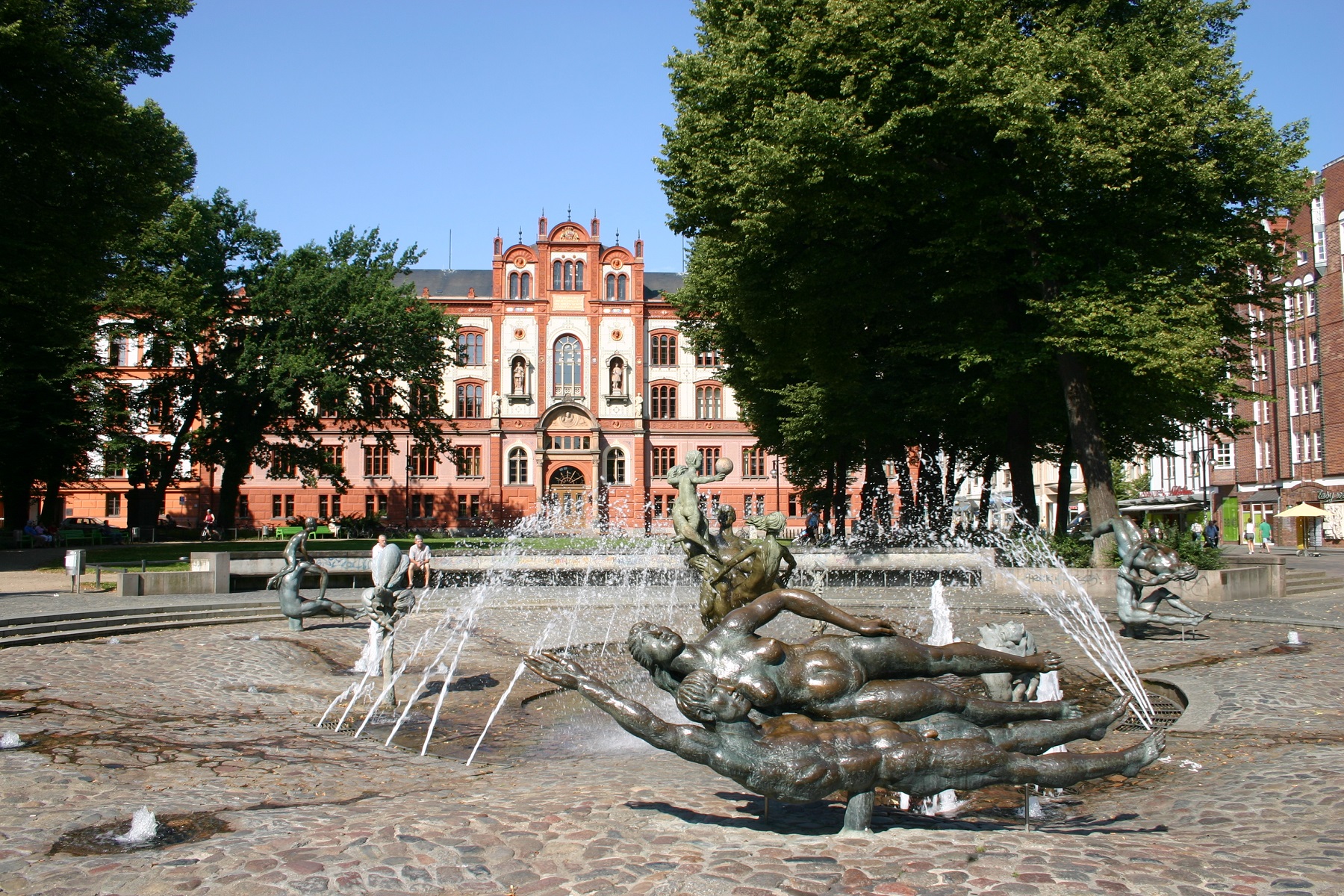
This square is located like a triangle on the street Kröpeliner Straße, and its name is due to the fact that the main building of the city’s university is located here.
On the square you can see a memorial monument for the city child and freedom hero Gebhard Leberecht von Blücher, who was born in Rostock in 1742. Von Blücher became Rostock’s first honorary citizen in his time.
You can also see an example of a beautiful variant of the so-called modular construction from the GDR era, Plattenbau, on Universitätsplatz. The five-storey building is built with respect for the town’s traditional Hanseatic architecture with gabled houses.
Rostock’s town hall has functioned as the town’s house for more than 700 years. Originally, it was built 1270-1290 as a two-storey building, which throughout the Middle Ages housed both the town’s assembly and various trades.
In 1484, the house was remodeled and extended, so that it radiated more prestige and refined construction. It is from this time that the seven preserved brick towers on top of the roof ridge originate.
The current facade in Baroque style was created in the early 1700s, and the beautiful Rathausfestsaal was also built here.
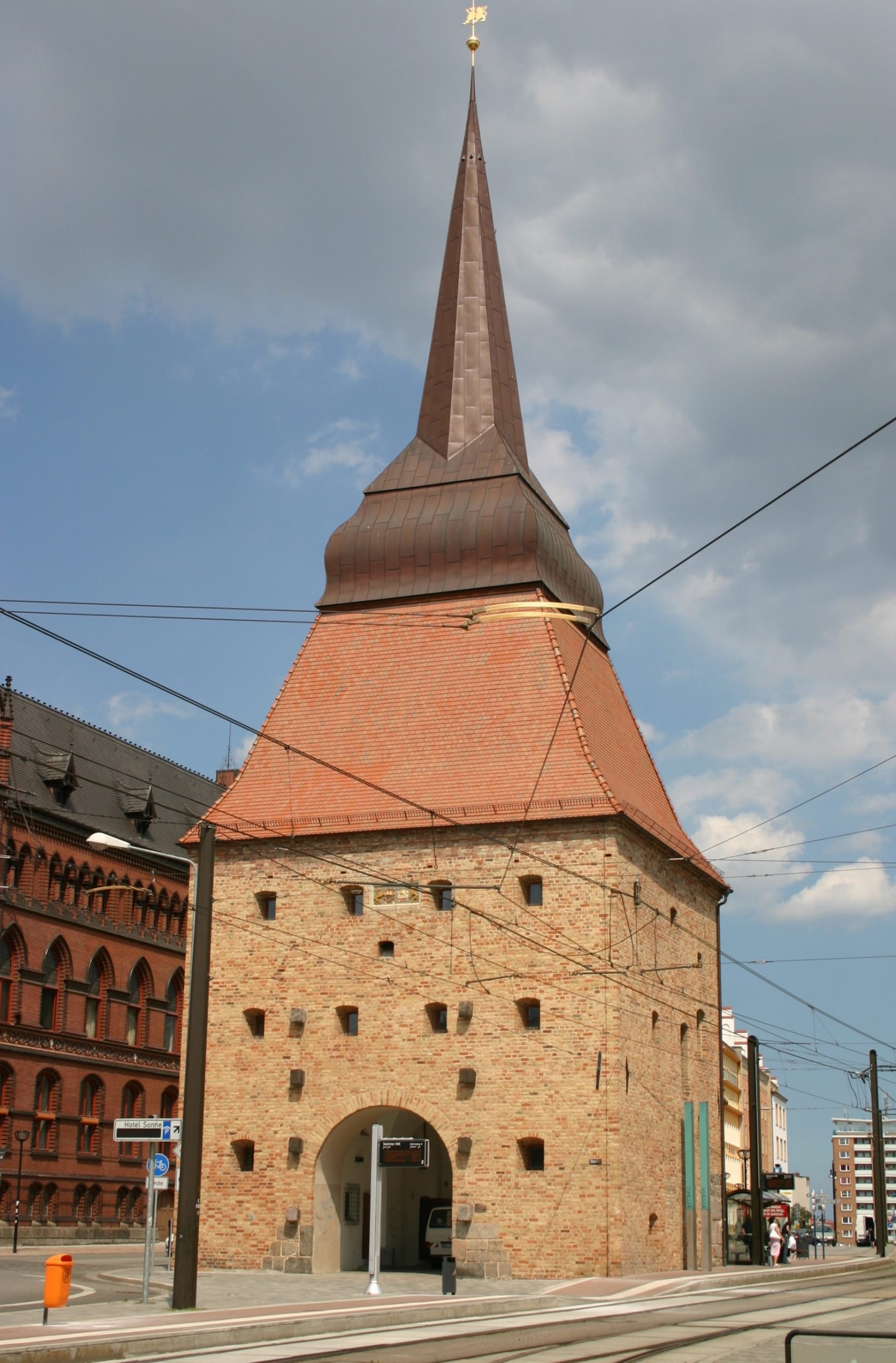
Steintor was built in 1279, and it became the city’s main gate to the south instead of Kuhtor. The first gate building stood until 1573, when it was demolished together with a piece of the city wall as a result of an agreement with the Duke of Schwerin.
In the years 1574-1577, the wall and Steintor were rebuilt. Steintor appeared this time in the Dutch Renaissance with an impressive portal and an almost colossal spire for a city gate.
The large Marienkirche was first started to be built around 1230, but the nearly completed church collapsed in 1398. The successor, the current one, is a cross church based on the French model and with inspiration from Lübeck’s Marienkirche. It became the city’s largest church building, befitting its status as the city’s leading parish church.
The church tower is newer than the rest of the church, as it was only completed at the end of the 18th century. Inside there is a lot to see. One of the oldest preserved parts is the baptismal font, which dates from 1290. According to the inscription, the font was put into use at Easter that year.
The high altar is from 1721, and there are three paintings on it. At the bottom the last supper, in the middle the resurrection and at the top the effusion of the Holy Spirit. Behind the high altar is the exciting astronomical clock from 1472. It was constructed by Hans Düringer from Nuremberg and, in addition to the clock and calendar, contains a part where Jesus’ disciples walk around in front of Jesus.
The pulpit from 1574 was the first decorative element that came here after the Reformation. A beautiful decoration is also the 26-metre-high window that depicts Judgment Day. It was made in the years 1894-1904. The church’s baroque organ was created in 1770 by the organ builder Paul Schmidt from Rostock.
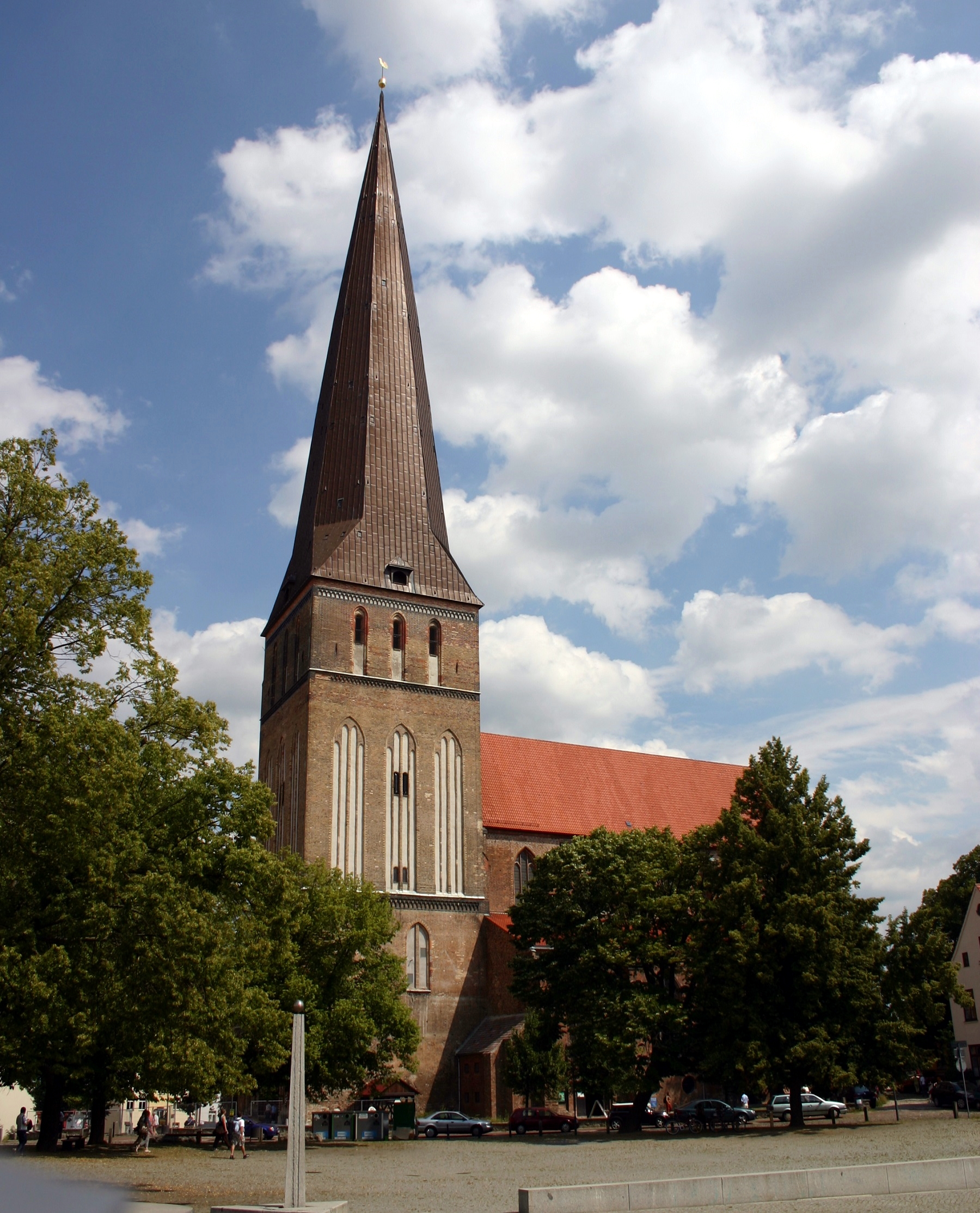
Sankt Petri Kirche, with its 117 meter high tower, can be seen from almost all of Rostock. The church is historically interesting because it marks the site of the city’s foundation, i.e. where the first Christian German settled in the present city area in the year 1200. The earliest Petri Kirche was a smaller building that was replaced in the mid-1400s by the church that stands today.
However, the high tower was only built in 1500, and it came to have a changeable life. Lightning struck in 1543 and the spire was destroyed. It was not rebuilt until 30 years later. However, only two years had to pass before a storm in 1575 brought the spire down to half its height. Two years later it was rebuilt to its full height, and over the following centuries countless damages occurred to the tower, but it always returned to its original appearance.
In 1942, the church’s spire and large parts of the church building itself were badly damaged during British bombardments. In the following decades, the church was resurrected little by little, and with the completion of another spire, the Petri Kirche stood ready again in all its splendor in 1995.
Next to the church is the cozy square, Alter Markt. Both here and in the side streets are a number of idyllic streets, where an almost rural calm prevails compared to the Neuer Markt a few hundred meters away.
The Herzogliche Palais is an interesting mansion that formerly belonged to the Dukes of Mecklenburg-Schwerin. It was built in 1714 under Duke Carl Leopold, who wanted to use the mansion during a visit to Rostock.
Carl Leopold’s art-interested successor, Duke Christian Ludwig, had a small theater built in the mansion in 1750. It is the now well-known Baroksaal, which is the main attraction of the mansion. It is today one of Northern Germany’s most beautiful party and concert halls.
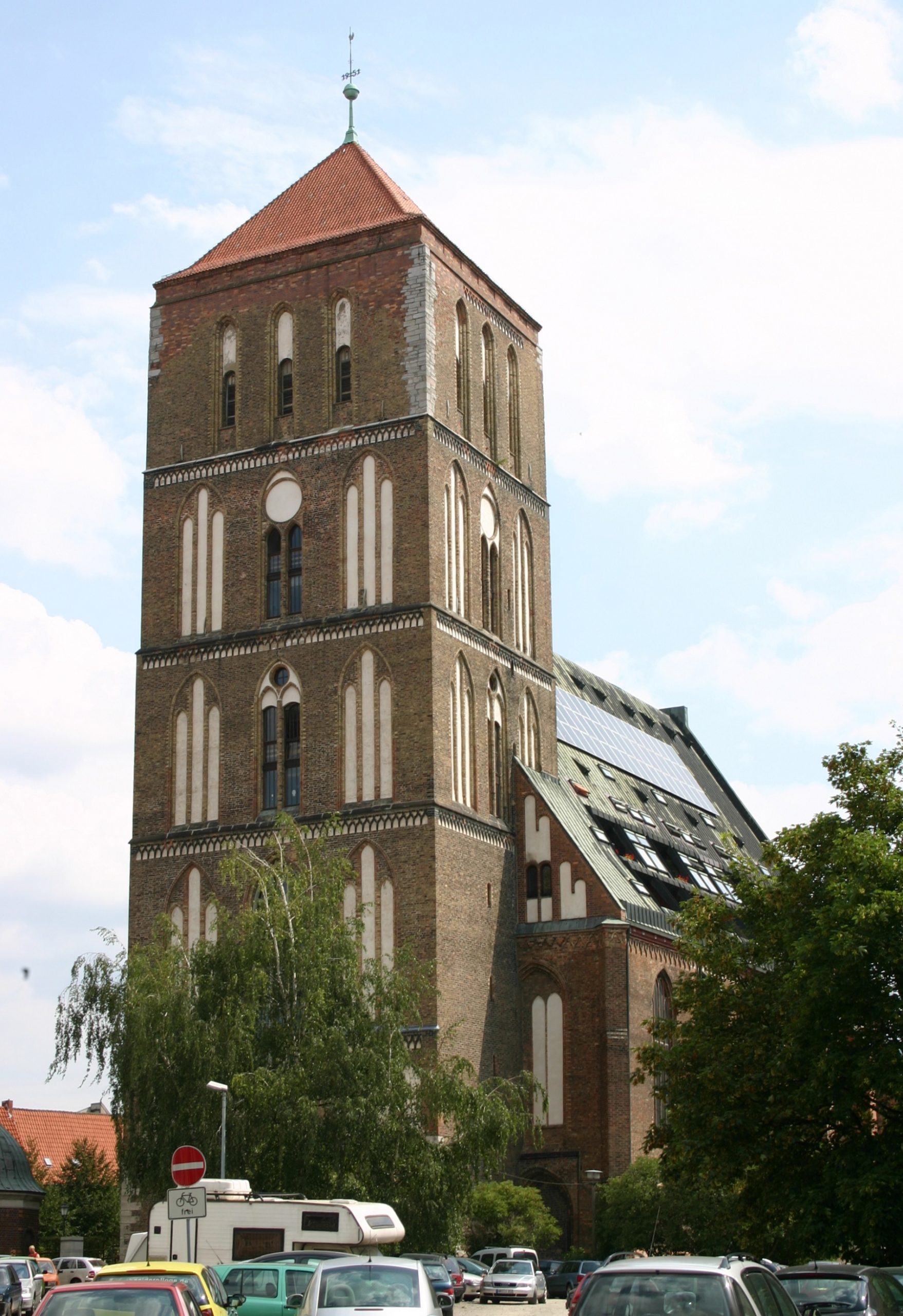
Nikolai Kirche is Rostock’s oldest preserved church building. However, its original purpose has been replaced with a number of other activities, which is clearly seen on, among other things, the roof, which is furnished with apartments and solar cells.
On the entrance door at the foot of the church tower, you can see that this part of the church functions as an ordinary staircase with apartments where there is a door phone. Concerts and exhibitions are held in the church space, which in many ways reflect the relationship between church, art and culture.
Mönchentor is one of the city gates from Rostock’s time as enclosed by city walls; it is the only one preserved on the so-called beach side. The gate was opened for the first time in 1316. In the 16th century, its Gothic style was rebuilt into the Renaissance of the time. However, the current classicist appearance came about with a rebuild in 1805-1806.
On Mönchentor’s 1st floor, an apartment was set up for the city’s lifeguard. In the apartment, the famous German-Australian botanist, Ferdinand von Müller, was born in 1825. Stranden was the name of the area along the water immediately north of the city itself, and today the road along the Warnow river is also called Am Strande.
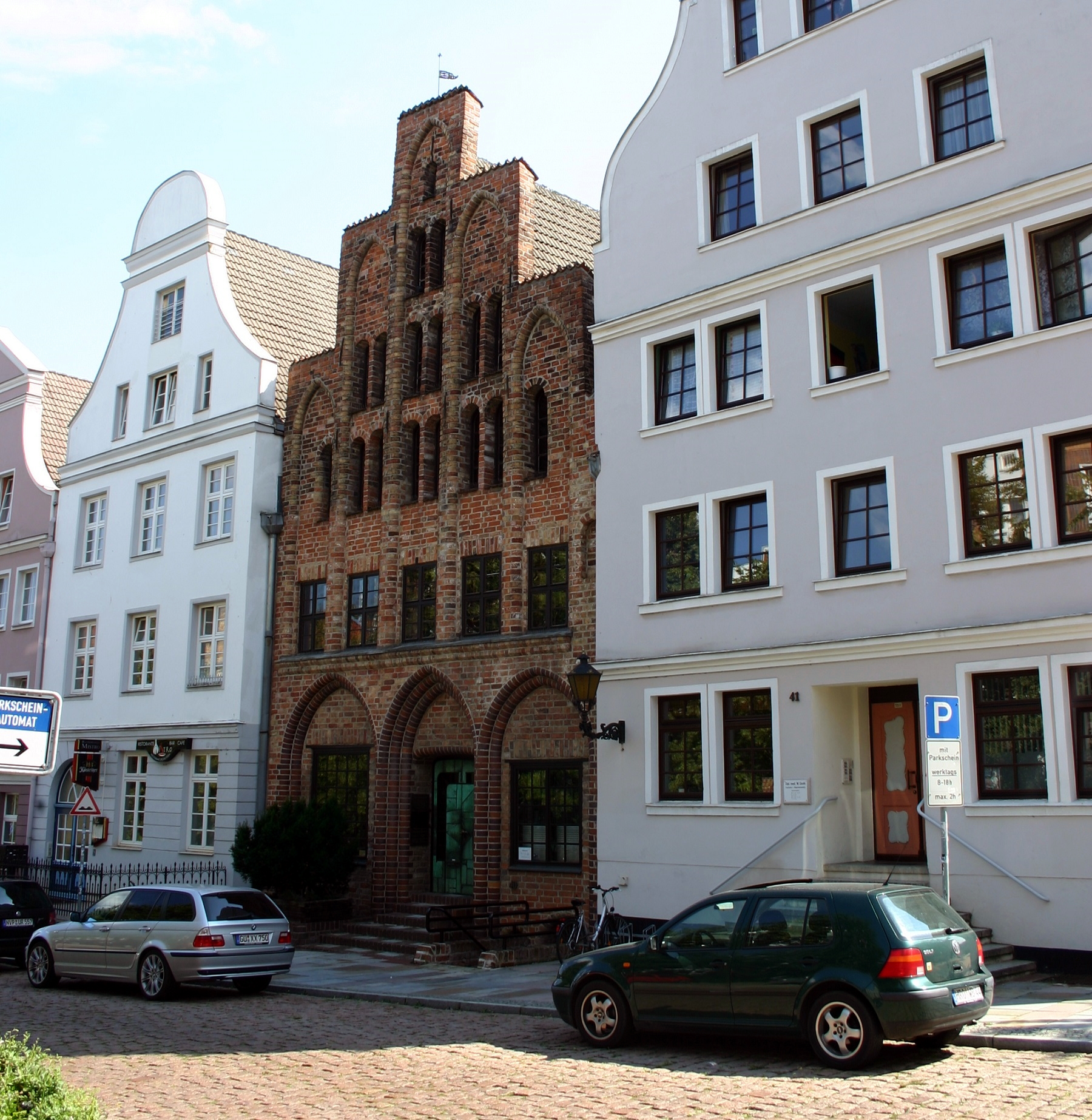
This is a late Gothic house in typical gable style. The house is named after its construction form, which is like a tree. The tree supports the stones in the house with the idea of a thick trunk at the bottom with branches at the top.
The house type with stepped gables is also seen elsewhere in the city, the most distinguished being the Ratschow-Haus (Kröpeliner Straße 83) and the Kerkof-Haus (Hinter dem Rathaus 5).
The streets around the Hausbaumhaus are some of Rostock’s old streets facing the Warnow river, and there are many nice places here. You can also see fine examples of modern construction from the 1980s, where modular construction was built with inspiration from the historic gabled houses.
Kröpeliner Tor is the name of the city gate that formed the historic access road to Rostock from the west. It was along this road that traders from, among other things, the Hanseatic cities of Lübeck and Wismar came to travel. The gate was built around 1300, but expanded in height over the following century until it reached an impressive 54 meters around 1400.
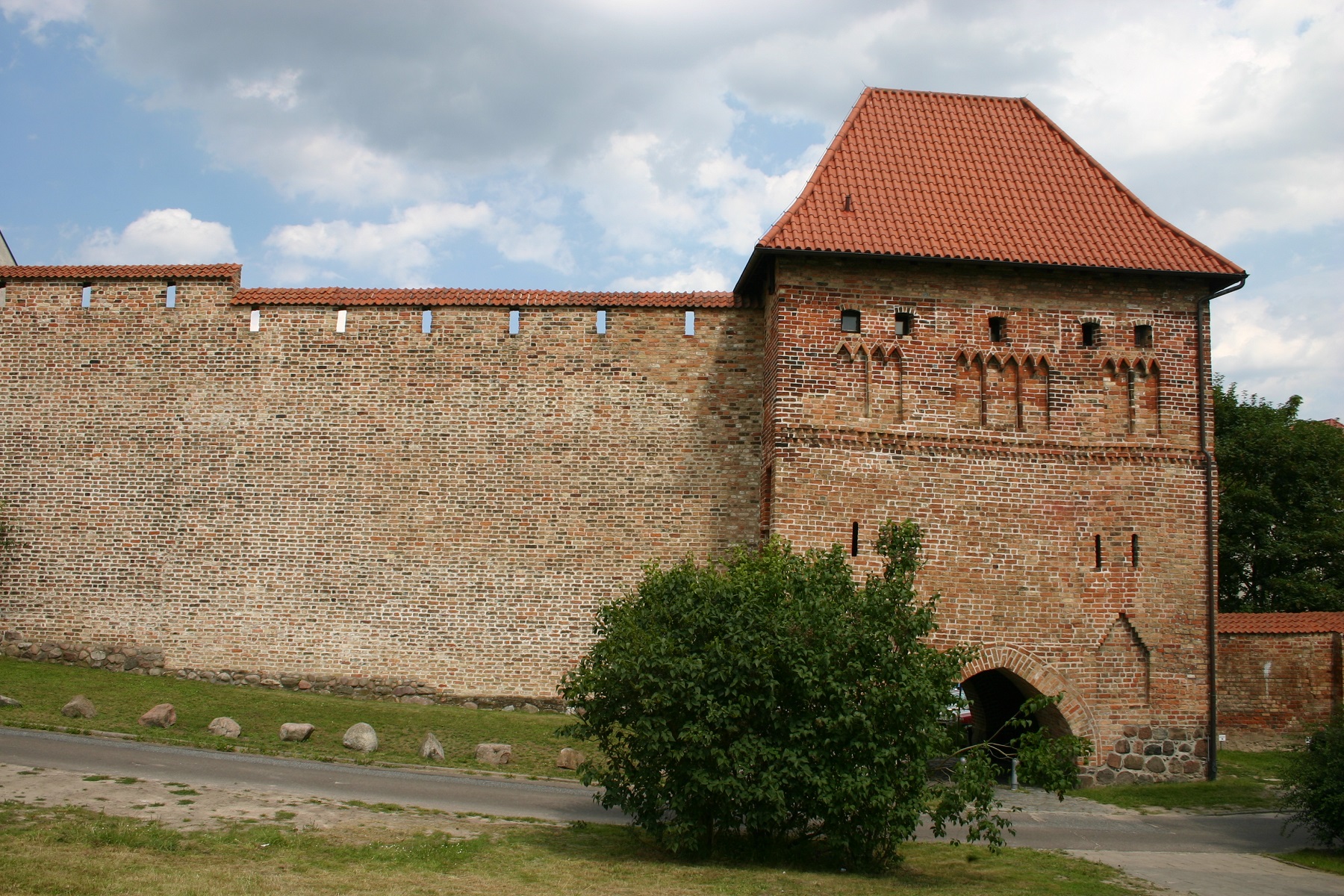
The city gate Kuhtor is the oldest in all of Mecklenburg, it was mentioned for the first time in 1262. The gate is built in style as an actual part of the city’s fortress, and it was originally the main gate to the south. Over time, the gate has been rebuilt several times and most recently sought to be reconstructed in a more original style.
To the west of Kuhtor in the direction of Steintor you can see a reconstructed part of Rostock’s city wall with a defense tower. The newly decorated square in front of the Kuhtor, within the city wall, the street Grubenstraße with a stream in the middle and the area towards the Neuer Markt is a cozy and peaceful place in the center of Rostock.
The area around the street Am Vögenteich is urban planning and architecturally interesting for the efforts to create a modern metropolis in the GDR. High-rise buildings in the style typical of the period stand as exemplary examples of the progress of the time, which was supposed to connect the new suburb, Südstadt, with the old part of the city.
As elsewhere in the former GDR, the classic Plattenbau element housing blocks have been modernized and greatly brightened up, the blocks are located to the southwest from Am Vögenteich.

Warnemünde is a port city located as a northern suburb of Rostock. The town was founded at the mouth of the river Warnow as a fishing village around the year 1200, and since then the town has grown into a seaside resort with around 10,000 inhabitants.
In Warnemünde there are several things to experience. In the summer, the city’s particularly wide and several kilometers long sandy beach is a major attraction for the entire area. The beach is the widest on the German coast along the Baltic Sea. Bathing life is supplemented maritimely by the nearby port, where you can go on several different sailing trips; among other things on harbor cruises in Rostock’s large harbor area, which extends to Warnemünde.
In Warnemünde’s old town there are several old fishermen’s houses and other beautiful buildings. From recent times, you can see the Tepotten/Teepott, which was built in a modern style in the GDR in 1967-1968. The Teepott is located right next to Warnemünde’s lighthouse, which was built in 1898 with a height of 36.90 meters.
In the center of the city runs the old river current, Alter Strom, and along the banks of the water there is a nice atmosphere with restaurants, pubs and ships along the quays. It was also here (Am Strom 53) that the Norwegian artist Edvard Munch lived in the years 1907-1908
Bad Doberan is a cozy town west of Rostock. It is a city with several attractions, and it is also from here that the famous narrow-gauge Mollibahn starts and runs through the streets of Bad Doberan on the way to Kühlungsborn and Heiligendamm.
One of the city’s experiences is Doberan Abbey/Kloster Doberan (Klosterstraße), which is a historic monastery complex with the beautiful church Doberaner Münster as the central and preserved part.

Heiligendamm is a spa town that was founded as such already in 1793. This makes it the oldest of its kind in Germany and continental Europe.
From its beginnings, Heiligendamm attracted distinguished guests. It was Friedrich Franz I who founded the city, and he was also the city’s first visitor. His visit made the place popular, which it still is.
In Heiligendamm you can enjoy the beaches and the beautiful spa buildings that surround the Grand Hotel Heiligendamm. The hotel is a complex of six elegant buildings built between 1793 and 1870.

Wismar is one of the historic North German Hanseatic cities, where you can see many old buildings in the so-called Brick Gothic architecture. The architecture is typical of the once prosperous cities of the Hanseatic League, and among other things, the three major churches radiate the atmosphere from the city’s economically thriving commercial history.
The churches of St. Georgen and St. Nikolai stand beautifully as the great old churches that are. The third of Wismar’s three mighty churches, the Marienkirche, was destroyed during World War II and is today it is only the church tower with the contours of the other buildings which remains. It provides an interesting perspective in the old center of the city.
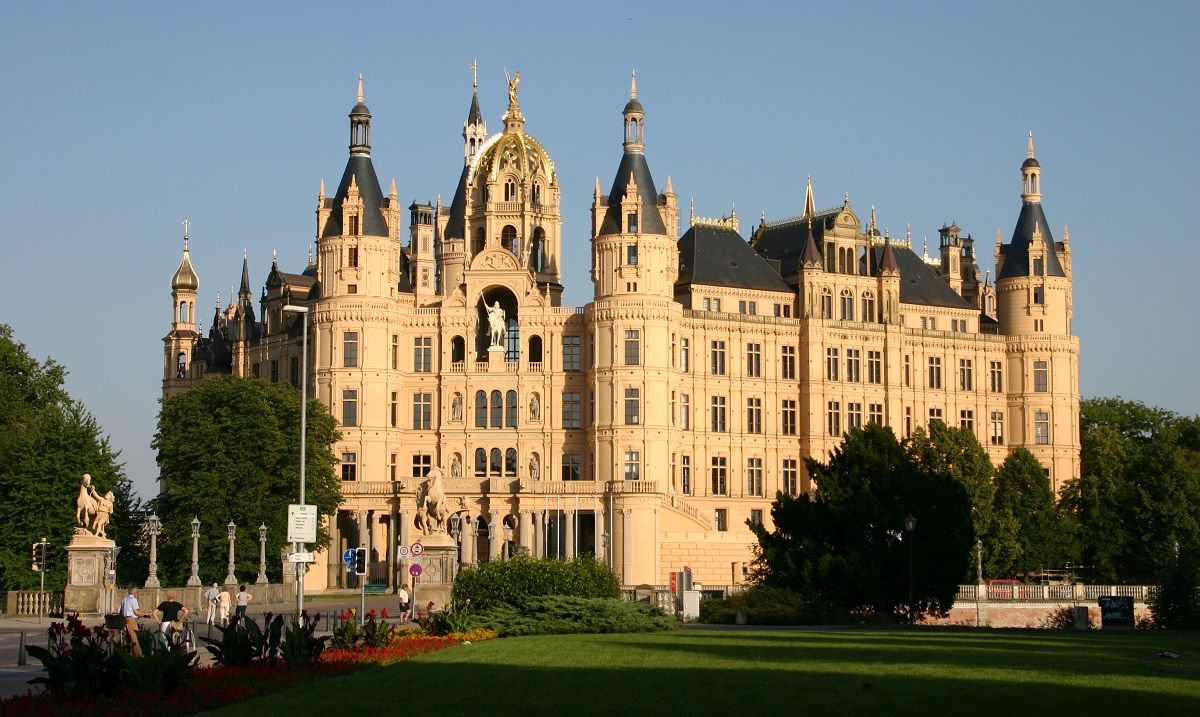
Schwerin is the capital of the state of Mecklenburg-Western Pomerania and the historic residence city of the dukes and grand dukes of Mecklenburg-Schwerin. It is the home to loads of elegant and magnificent buildings in the beautifully situated town on the lake Schweriner See, where you can enjoy various lovely lake cruises.
The most famous building is Schwerin Palace, which is a true fairy tale castle with its many towers and spiers. It is a must to visit during a tour of the city, but there are also many other large buildings within a pleasant walking distance. Along the way you can enjoy the fine pedestrian streets and squares located in the old town.
Güstrow is a city in Mecklenburg-Western Pomerania with a city center worth seeing that has been built up through centuries of exciting development. Today, the city is known for, among other things, its Renaissance castle, which stands on the site where a Wendish castle was already built in 1219.
Today’s castle in Güstrow was built from 1558 by Duke Ulrich of Mecklenburg. The time was in the Renaissance, and in terms of style, the castle is an interesting mix of German, French and Italian architecture. In the middle of the 17th century, the last duke of Güstrow had the castle modernized with the baroque gatehouse and the castle bridge that leads from the gatehouse to the castle. Today the castle is set up as a museum, and below the beautiful building you can take a walk in the castle’s impressive garden.
In addition to the castle, there are many other sights in Güstrow, where you can take a short walk in the old town. Here you will find, among other things, Markedet/Markt, where the city’s elegant town hall is located. Just behind the town hall you can visit Our Lady Parish Church/Pfarrkirche St. Marien, which in its original version was consecrated in 1308.
Not far from Market and St. Marie is the Güstrow Domkirke/Güstrower Dom (Domplatz), which is an impressive church building in the typical North German brick Gothic style. The church was completed in 1335, and in addition to the building itself, Ernst Barlach’s famous sculpture Den Svævende/Der Schwebende can be seen here.
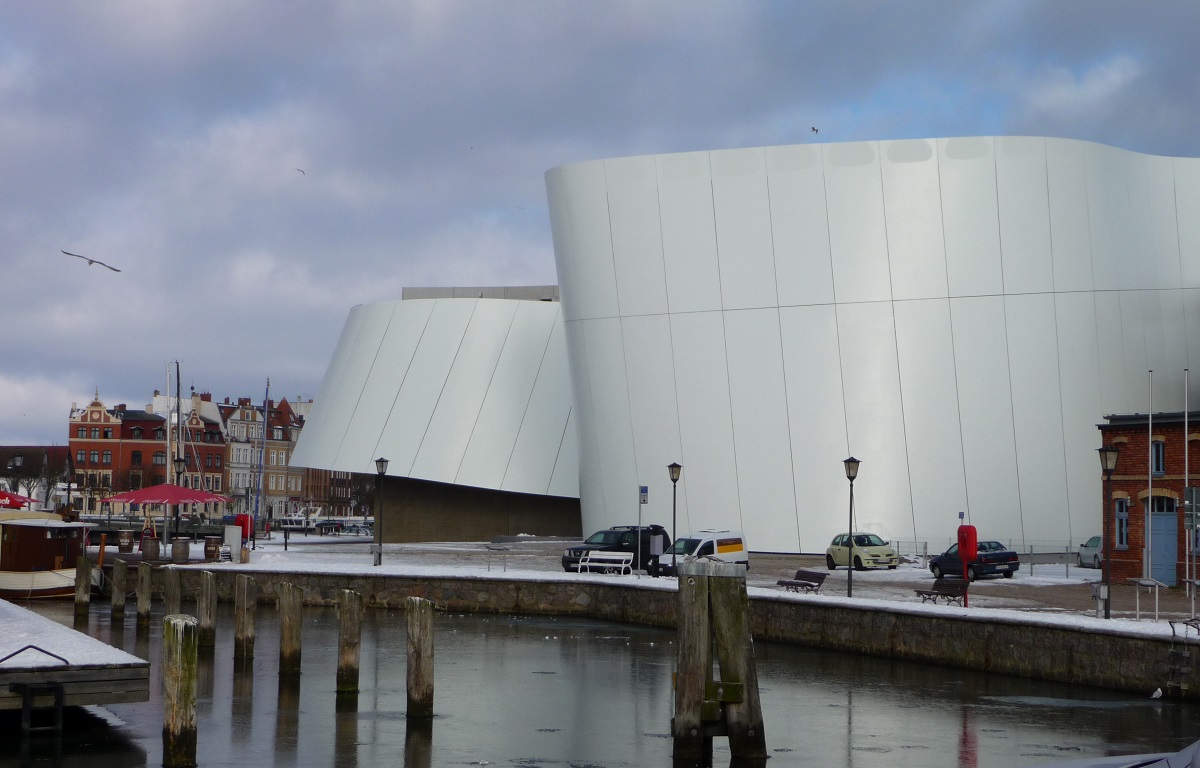
Stralsund’s rich history as a thriving Hanseatic city can be seen in many places in the beautiful Old North German town, where merchant buildings are located in the streets between the three large churches and other public buildings erected as symbols of the city’s ability and wealth during the Middle Ages.
The many small streets are evocative as of a bygone era, and one quickly discovers why the city center is on UNESCO’s list of world heritage sites. As you approach Stralsund, you immediately see the city’s great medieval churches; St. Nikolai, St. Marien and St. Nikolai. They are all sights and worth a visit, and in the streets around them it is just about exploring.

Greifswald is a Hanseatic city on the river Ryck, and it is a cozy city with everything that belongs to the character of a Northern German city with roots in the Baltic Sea trade. Beautiful buildings, impressive churches, a central market square and an elegant city hall are just some of the highlights.
Compared to other North German Hanseatic cities, Greifswald is a relatively small town, and it provides the opportunity to easily experience the city on foot. It is not far between the sights, where St. Nicholas Cathedral, the Market Square and the Museum Harbor are good choices for a walk.
Lange Straße 29-31
galeria-kaufhof.de
Kröpeliner Straße 26-28
rostockerhof.de
Hanse Straße 37, Bentwisch
hansecenter-bentwisch.de
Werftstraße 50
neptuneinkaufcenter.de
Goostorfer Street 50
real.de
Kröpeliner Straße, Breite Straße, Lange Straße, Doberaner Platz
Hafenrundfahrt
Am Strand
rostocker-flotte.de
Molli-Bäderbahn
Bad Doberan Bf.
molli-bahn.de
Zoo Rostock
Rennbahnallee 21
zoo-rostock.de
Rostock is the largest city in Mecklenburg-Western Pomerania, and it is one of Germany’s largest port cities, due in part to its proximity to Berlin just a few hours drive to the south. However, the start was quiet, for centuries from the 600s it is thought to have spread settlement here south of the mouth of the Warnow River.
Slaves are believed to have founded the actual town of Roztoc in the 11th century. In 1161, the Danish King’s troops destroyed Roztoc, which was subsequently rebuilt. The town was located around the present Alte Markt, and around 1200 the German Rostock was founded at the present St. Petri Church. Shortly thereafter, a new district was established at the Neuer Markt, and thus two Rostocks were close to each other. In 1218, Rostock was first described, so at that time the town was obviously established.
1251 was the year in which Danish King Abel granted Rostock commercial and commercial rights identical to Lübeck’s, and thus began the path towards status as one of the rich Hanseatic cities. In the competition with other North German trading towns, not least Lübeck and Wismar, Rostock erected city walls in the 13th century, and they became the limit for the city’s growth until the 19th century.
In 1283, a larger federation of northern German trading towns was founded, the Rostocker Landfriedensbündnis, and with that the focus was on protection and development of trade. In 1323, Rostock bought Warnemünde from the Danes, and thus Rostock’s trade could grow further. Two years later, the city gained coin rights and the coin foot Rostocker Pfennige was minted. All in all, Rostock’s importance and cultural development emphasized the city as well, among other things, the university was already founded in 1419.
Rostock developed in the Hanseatic League until the Thirty Years War finally put an end to Hansen. Repeated looting was exposed to the city before it had to capitulate in 1631 to the Swedes who ruled Rostock until 1648, when they retreated to Warnemünde. As if that wasn’t enough, about a third of the city burned down in 1677, and the city’s inhabitants had fallen from 15,000 to 5,000 since the heyday of the late 1500s. Rostock’s importance and success as a trading town was gone for a period of time.
By the end of the 18th century conditions had improved and Rostock was again on the road to better times. France occupied Mecklenburg in 1806, and Rostock had to submit to French demands and conditions. The village child Gebhard Leberecht von Blücher was one of those who fought against France, and he is honored to this day in his native city.
The 19th century brought industrialization to Rostock, and in 1830 the city broke out of its boundaries, which until then had been cut off by the lines of the old city walls. Founded in 1891, the Neptune shipyard was one of Mecklenburg’s largest industries. At the same time, Warnemünde was established as one of the most visited German spa towns, and it all brought new prosperity to Rostock.
The positive development continued at the beginning of the 20th century, when the Heinkel aircraft factory was founded in 1922. Heinkel, among other things, produced the world’s first functional jet aircraft. Starting from the Heinkel factory and the city’s yards, Rostock became one of the centers for the armor industry in the years up to and during World War II. As a result, English bombings destroyed parts of both Rostock and Warnemünde as early as 1942. Only about 20% of Rostock’s residential houses escaped unscathed throughout the war years, which is why a major reconstruction work was undertaken by the GDR from 1945.
In the 1950s, prestigious buildings were erected in Rostock in the so-called socialist or Soviet classicism, and the impressive buildings can be seen among others in Lange Straße. The redevelopment in the center has generally been done with modern buildings adapted to the historic Hanseatic style with gabled houses, and it has given the city center an exciting mix of old and new that is not seen in other Hanseatic cities of the state. In the suburbs of Rostock, you can see some of the large residential buildings in components, Plattenbau, that were supposed to alleviate the housing need in a city that became increasingly important during the GDR.
Rostock became the port of Berlin after the Polish takeover of Stettin / Szczecin, and shipping, trade and shipbuilding once again marked the old Hanseatic city. In 1988, the population reached 250,000.
In recent years, the city center has been extensively renovated and many new buildings have been renovated. The traffic network has been expanded with, among other things, a tunnel under the Warnow River, and the efficient tram network almost newly constructed. It was thus a very efficient and beautiful city, hosted by the G8 meeting in the spring of 2007 and welcoming tourists today.
 Rostock, Germany[/caption]
Rostock, Germany[/caption]
Overview of Talkeetna
Rostock is one of the northern German cities, which grew with the Hanseatic League’s trade and financial success, and its historical wealth has been the source to a lot of constructions, that can be seen today as well. Large churches, the region’s oldest university and a lot of culture are some of the things you can look forward to in Rostock, which has also benefited from the investments of both former dukes and the GDR.
Rostock is a small metropolis with all that it entails. Business districts and shopping malls, good restaurants and a varied cityscape provide many choices of activities during a visit. A walk in the city center is the best way to explore the city where it is never far between sights.
Rostock’s churches and gates stand as some of the city’s highlights from the booming era of rich trade around the Baltic Sea, including the time of the Hanseatic League. Marienkirche and Sankt Petri Kirche are the two best known churches, while Nikolaikirche’s new apartments in part of the building are quite special. In addition, several preserved city gates and parts of the wall from Rostock’s defense are still to see.
About the Whitehorse travel guide
Contents: Tours in the city + tours in the surrounding area
Published: Released soon
Author: Stig Albeck
Publisher: Vamados.com
Language: English
About the travel guide
The Whitehorse travel guide gives you an overview of the sights and activities of the Canadian city. Read about top sights and other sights, and get a tour guide with tour suggestions and detailed descriptions of all the city’s most important churches, monuments, mansions, museums, etc.
Whitehorse is waiting for you, and at vamados.com you can also find cheap flights and great deals on hotels for your trip. You just select your travel dates and then you get flight and accommodation suggestions in and around the city.
Read more about Whitehorse and Canada
Canada Travel Guide: https://vamados.com/canada
City tourism: https://visitwhite-horse.ca
Main Page: https://www.vamados.com/
Buy the travel guide
Click the “Add to Cart” button to purchase the travel guide. After that you will come to the payment, where you enter the purchase and payment information. Upon payment of the travel guide, you will immediately receive a receipt with a link to download your purchase. You can download the travel guide immediately or use the download link in the email later.
Use the travel guide
When you buy the travel guide to Whitehorse you get the book online so you can have it on your phone, tablet or computer – and of course you can choose to print it. Use the maps and tour suggestions and you will have a good and content-rich journey.

Sankt Petri Kirche, with its 117 meter high tower, can be seen from almost all of Rostock. The church is historically interesting because it marks the site of the city’s foundation, i.e. where the first Christian German settled in the present city area in the year 1200. The earliest Petri Kirche was a smaller building that was replaced in the mid-1400s by the church that stands today.
However, the high tower was only built in 1500, and it came to have a changeable life. Lightning struck in 1543 and the spire was destroyed. It was not rebuilt until 30 years later. However, only two years had to pass before a storm in 1575 brought the spire down to half its height. Two years later it was rebuilt to its full height, and over the following centuries countless damages occurred to the tower, but it always returned to its original appearance.
In 1942, the church’s spire and large parts of the church building itself were badly damaged during British bombardments. In the following decades, the church was resurrected little by little, and with the completion of another spire, the Petri Kirche stood ready again in all its splendor in 1995.
Next to the church is the cozy square, Alter Markt. Both here and in the side streets are a number of idyllic streets, where an almost rural calm prevails compared to the Neuer Markt a few hundred meters away.
The Herzogliche Palais is an interesting mansion that formerly belonged to the Dukes of Mecklenburg-Schwerin. It was built in 1714 under Duke Carl Leopold, who wanted to use the mansion during a visit to Rostock.
Carl Leopold’s art-interested successor, Duke Christian Ludwig, had a small theater built in the mansion in 1750. It is the now well-known Baroksaal, which is the main attraction of the mansion. It is today one of Northern Germany’s most beautiful party and concert halls.

Nikolai Kirche is Rostock’s oldest preserved church building. However, its original purpose has been replaced with a number of other activities, which is clearly seen on, among other things, the roof, which is furnished with apartments and solar cells.
On the entrance door at the foot of the church tower, you can see that this part of the church functions as an ordinary staircase with apartments where there is a door phone. Concerts and exhibitions are held in the church space, which in many ways reflect the relationship between church, art and culture.
Mönchentor is one of the city gates from Rostock’s time as enclosed by city walls; it is the only one preserved on the so-called beach side. The gate was opened for the first time in 1316. In the 16th century, its Gothic style was rebuilt into the Renaissance of the time. However, the current classicist appearance came about with a rebuild in 1805-1806.
On Mönchentor’s 1st floor, an apartment was set up for the city’s lifeguard. In the apartment, the famous German-Australian botanist, Ferdinand von Müller, was born in 1825. Stranden was the name of the area along the water immediately north of the city itself, and today the road along the Warnow river is also called Am Strande.

This is a late Gothic house in typical gable style. The house is named after its construction form, which is like a tree. The tree supports the stones in the house with the idea of a thick trunk at the bottom with branches at the top.
The house type with stepped gables is also seen elsewhere in the city, the most distinguished being the Ratschow-Haus (Kröpeliner Straße 83) and the Kerkof-Haus (Hinter dem Rathaus 5).
The streets around the Hausbaumhaus are some of Rostock’s old streets facing the Warnow river, and there are many nice places here. You can also see fine examples of modern construction from the 1980s, where modular construction was built with inspiration from the historic gabled houses.
Kröpeliner Tor is the name of the city gate that formed the historic access road to Rostock from the west. It was along this road that traders from, among other things, the Hanseatic cities of Lübeck and Wismar came to travel. The gate was built around 1300, but expanded in height over the following century until it reached an impressive 54 meters around 1400.

The city gate Kuhtor is the oldest in all of Mecklenburg, it was mentioned for the first time in 1262. The gate is built in style as an actual part of the city’s fortress, and it was originally the main gate to the south. Over time, the gate has been rebuilt several times and most recently sought to be reconstructed in a more original style.
To the west of Kuhtor in the direction of Steintor you can see a reconstructed part of Rostock’s city wall with a defense tower. The newly decorated square in front of the Kuhtor, within the city wall, the street Grubenstraße with a stream in the middle and the area towards the Neuer Markt is a cozy and peaceful place in the center of Rostock.
The area around the street Am Vögenteich is urban planning and architecturally interesting for the efforts to create a modern metropolis in the GDR. High-rise buildings in the style typical of the period stand as exemplary examples of the progress of the time, which was supposed to connect the new suburb, Südstadt, with the old part of the city.
As elsewhere in the former GDR, the classic Plattenbau element housing blocks have been modernized and greatly brightened up, the blocks are located to the southwest from Am Vögenteich.
Similar to Rostock Travel Guide